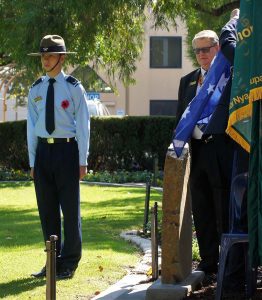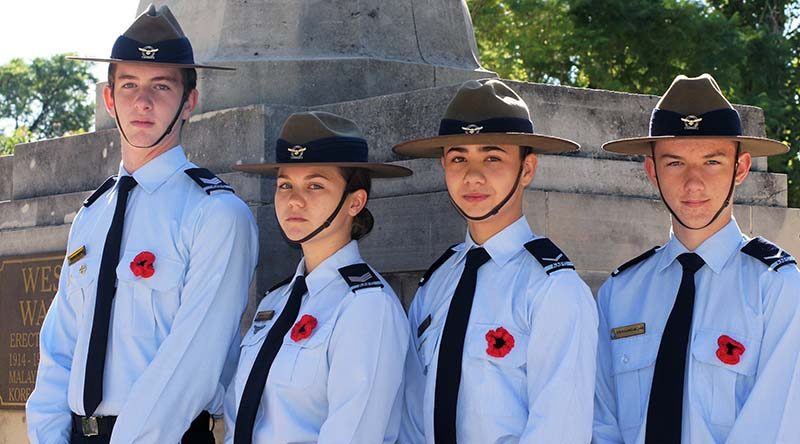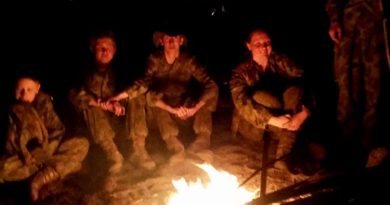HONOURING ANZAC DAY TRADITIONS, Part 3

The Poppy
AAFC Cadets promise to remember our Diggers
There are many customs and traditions associated with commemorative activities and, as new generations emerge, some of these customs evolve.
CAPTION: Cadet Sergeant Blake Lawrence, Cadet Sergeant Britney Shorter, Leading Cadet Zain Carse and Leading Cadet Byron Barnes-Williams of No 604 Squadron, wear poppies in the left-brett pocket flap, as allowed in the AAFC dress manual.
For decades in Australia and the United Kingdom, the wearing of a single red poppy was a tradition reserved solely for Armistice Day, 11 November – later known as Remembrance Day.
In New Zealand however, the poppy was always very much part of their Anzac Day tradition.
Increasingly now, poppies are also being worn on Anzac Day in Australia or laid as a personal tribute at memorials or placed beside the names of family members on War Memorials and Honour Rolls.
Air Force Cadets will continue this tradition on Anzac Day to honour those who gave their lives, to ensure that we will remember them.
Pilot Officer (AAFC) Paul Rosenzweig, Public Affairs & Communication Officer for No 6 Wing AAFC, said, “Anzac Day activities are an opportunity for solemn commemoration of the sacrifice of the nearly 103,000 Australian Service personnel who have lost their lives in the service of the nation”.

“Many of them, particularly from World War 1, served as Cadets before joining up for overseas service,” he said.
“It is appropriate that Air Force Cadets in uniform may wear a poppy to signify remembrance of the fallen.”
The AAFC Manual of Dress allows that, during the Anzac Day observance period, a poppy may be worn on the left pocket flap by cadets attending an activity such as an Anzac March or a Youth Vigil.
Why a red poppy? As World War I raged across Europe, fields and farmlands were turned into barren wasteland by the continued bombing and digging. Yet in Flanders, Belgium, where the fighting was at its fiercest, as the soldiers ventured out of the trenches in early spring they were greeted by a carpet of red – as the local ‘Corn Poppy’ began emerging from the recently bombed soil. This Poppy flourished in trenches and craters, as artillery shells and shrapnel stirred up the earth and exposed the seeds to the light they needed to germinate.
Australian diggers had already seen the Corn Poppy – it also flowers in early spring in Turkey, and a valley south of ANZAC Beach got its name ‘Poppy Valley’ from the field of brilliant red poppies near its mouth.
The flower became known as the ‘Flanders Poppy’, and was the inspiration for Lieutenant Colonel John McCrae, a Canadian artillery officer and military doctor, to pen the poem “In Flanders Fields” in May 1915.
The poem was printed in the 8 December 1915 issue of Punch and soon became the unofficial anthem of the soldiers in the trenches where it was memorised and passed on by word of mouth.
The Flanders Poppy became a symbol of regeneration, and wearing a poppy soon became a tradition among those wishing to remember the soldiers who had not returned.
Lest we Forget
In Flanders Fields
In Flanders fields the poppies blow
Between the crosses, row on row,
That mark our place; and in the sky
The larks, still bravely singing, fly
Scarce heard amid the guns below.
We are the Dead. Short days ago
We lived, felt dawn, saw sunset glow,
Loved and were loved, and now we lie
In Flanders fields.
Take up our quarrel with the foe:
To you from failing hands we throw
The torch; be yours to hold it high.
If ye break faith with us who die
We shall not sleep,
though poppies grow
In Flanders fields.
.
HONOURING ANZAC DAY TRADITIONS – PART 2
HONOURING ANZAC DAY TRADITIONS – PART 1
.
.
.
.
.
.
.

.
.








A bit of trivia for anyone that may be interested. The first poppies were made in France and the first order for New Zealand was on a boat bound for New Zealand and Australia in 1921. However due to inclement weather the boat was late and the poppies arrived after November 11 (Armistice Day). It was decided that the poppies should be saved for Anzac Day. We seem to have adopted Anzac Day as our poppy day.
The Australian Air Force Cadets (AAFC) is a youth oriented organisation which operates in a military and aviation environment, but Cadets are not members of the Australian Defence Force. For recruitment enquiries in South Australia (cadets, instructors, staff) pls contact:
paco.6wg@aafc.org.au